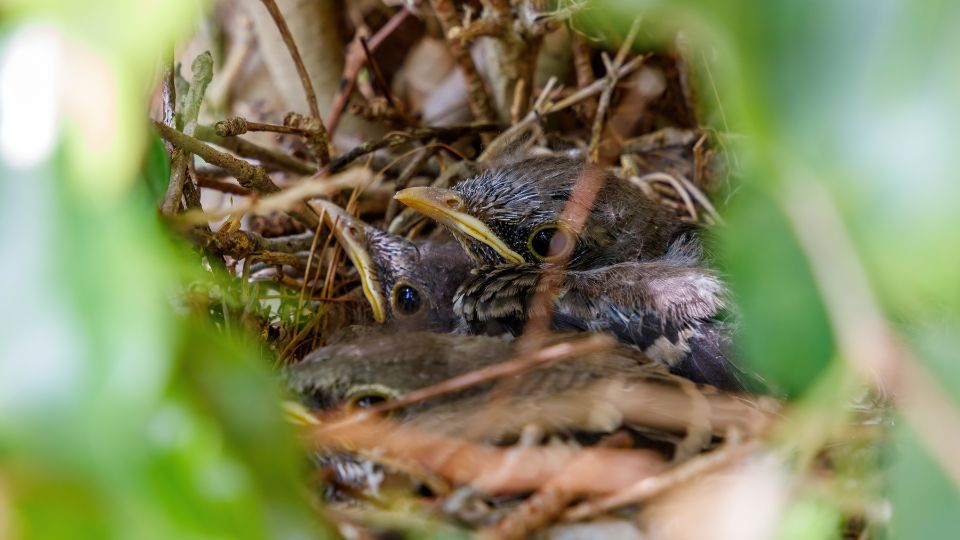Northern mockingbirds lay eggs during their nesting season between April and July. If you find a nest that has been abandoned, or disturbed, you should wait to see if the parent mockingbird returns. Mockingbirds will abandon their eggs if their is any predatory danger, which includes interference from humans.
You discovered an abandoned Mockingbird nest with no signs of its mother. Before you take it upon yourself to care for these eggs, there are a few things that you need to observe and consider before laying the eggs.
If you stumble across an abandoned Mockingbird nest or a nestling that has fallen from the nest, follow these tips to ensure that these young songbirds have the best chance at a full life!
What Do Mockingbird Nests Look Like?
Northern Mockingbirds lay their eggs in nests situated at least three to ten feet off the ground. Their nests are made from dead twigs, with soft materials such as leaves and grass.
While the nest doesn’t have many distinct features compared to other songbirds, the color of the eggs is an easy way to identify a Mockingbird nest. Each brood contains between two-six eggs, and the eggs are a pale blue or green with splotches of red or brown. The eggs are pretty small and measure .6-.8 inches wide.

How Long Do Mockingbird Eggs Take to Hatch?
Once the female is finished laying her brood, the incubation period takes between 12 and 13 days. After 12 days, nestlings will hatch from the eggs. The hatchlings will stay in the nest for an additional 12 days. They are born blind and helpless and rely on food from the male Mockingbird.
It’s important to note that females don’t incubate until she finishes laying their eggs. If you notice a Mockingbird nest that looks abandoned with only one egg, it likely means that the female is still laying more eggs.
In the video below, we rounded up 10 of the most fascinating facts about mockingbirds!
How To Tell If A Nest Is Abandoned
A nest with eggs and no birds doesn’t necessarily mean the nest has been abandoned. The female Mockingbird does not incubate the eggs until she is finished laying her brood.
Eggs that have not been incubated can survive up to two weeks, so a motherless nest doesn’t mean the eggs are abandoned. However, there are a few circumstances where a female Mockingbird will leave the nest, as listed below.
A predator killed the parent. If you find that the nest hasn’t been visited for some time, a predator likely killed the parent. In some bird circles, male birds will incubate the nest if something happens to the female. This is not the case with Mockingbirds.
The nest is close to predators. Sometimes, Mockingbirds abandon the nest if they feel it is too close to humans or other predators. Instead of taking the risk of becoming prey, the female will leave the nest altogether.

Tips to Protect a Mockingbird Nest
Try not to check in on the nest too frequently. Sometimes, adult Mockingbirds become spooked when there is too much human activity around their nest. Try and check on the eggs one month after the suspected hatch date and no more than that.
Give the nest some much-needed space. Even though you are concerned about the nest and its eggs, you mustn’t hover too closely. If the nest is in a busy area of your backyard, be sure to tell guests to steer clear of that area.
Try your best to protect the nest against predators. If you have dogs or cats, attempt to steer pets away from that yard area. The parent may abandon the nest if there is constant traffic from potential predators.
What To Feed A Baby Mockingbird
If you find a nestling on the ground, the most important thing you can do is track down the nest to put it back. Nestlings are easy to spot because they are blind and featherless and constantly chirp because they are hungry.
The best thing you can do for this little bird is to place it back with its young Mockingbird siblings. If you can’t find the nest, you can also care for the baby bird yourself.
In the wild, hungry babies eat things like earthworms, crickets, and mealworms from their parents. Since you likely don’t have access to these bugs, you must make do with other food sources.
Things like cat food or baby food are great alternatives to the food they get from their parents. Soak the food in plenty of water until it‘s spongy. Hand feeding them is ideal and ensures they won’t choke on their food. Baby mockingbirds are about the size of a hummingbird, so using a small syringe is the best way to deliver their food.
The Difference Between a Nestling and a Fledgling
Nestlings are often entirely naked without any feathers and are usually blind within the first few weeks of their life. Mockingbird fledglings, however, aren’t blind and have small tufts of down feathers that are starting to grow and large beaks that look too big for their tiny heads.
Before you help a young bird, it’s essential to know the difference. Nestlings need your help, while fledglings are more adept as they learn about the world around them. Before you intervene, ensure that the bird in question is a nestling, not a fledgling.
What Not To Do With An Abandoned Nest
Don’t ever handle Mockingbird eggs! While the nest may seem abandoned, in most cases, it‘s not. These eggs are incredibly delicate, and handling them may cause them to break.
Caring for backyard birds is important, but sometimes you need to call in the experts. If you are unsure what to do with abandoned or injured Mockingbird chicks, it’s better to call in a wildlife rehabilitator. Depending on the circumstances, a wildlife expert will come and take the nest or give tips on caring for your wild songbirds.
The best way to care for your backyard songbirds is by providing plenty of food, clean bird baths, and protection from predators. Always keep your bird feeders clean, and offer protein-rich foods (like mealworm suet) in the wintertime. In most cases, it’s better to leave the nest alone rather than interfere too much.

